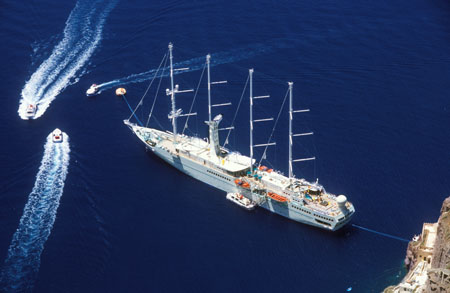Commercial aircraft have small windows that restrict the field of view available even from window seats. The windows are very thick and cause distortion, blurring and loss of detail. Their inner surfaces may be scratched and dirty. For best results place the front of the lens very close to the window without actually making contact. This minimizes reflections from within the cabin and avoids picking up the vibration of the engines. The best seats for photography are towards the front of the aircraft where the view is unobstructed by wings, engines or vapour trails. Low-altitude shots, usually taken just after take-off or shortly before landing, are often the most satisfactory because the landscape is closer and hence clearer. Use automatic exposures and a fast shutter speed, and focus at infinity. Depth of field is not an issue. If seated further back in the cabin, try including a wing in the composition. This tells the viewer how the picture was taken.
 Photography from light aircraft may be made easier, with the agreement of the pilot, by opening a window and orientating the aircraft to give the best view. Windows also tend to be larger than on commercial aircraft and the field of view therefore wider. High-wing aircraft offer the best views provided the undercarriage is not visible. However vibration and movements caused by air turbulence are likely to be more severe than in larger aircraft. Try not to touch the window or wall of the aircraft as this will transmit vibration to the camera. Use a fast shutter speed of at least 1/500 sec and keep shooting because movement relative to the landscape is quite rapid. Keep the camera inside the cabin, because the slipstream outside the window will make it impossible to hold the camera steady.
Photography from light aircraft may be made easier, with the agreement of the pilot, by opening a window and orientating the aircraft to give the best view. Windows also tend to be larger than on commercial aircraft and the field of view therefore wider. High-wing aircraft offer the best views provided the undercarriage is not visible. However vibration and movements caused by air turbulence are likely to be more severe than in larger aircraft. Try not to touch the window or wall of the aircraft as this will transmit vibration to the camera. Use a fast shutter speed of at least 1/500 sec and keep shooting because movement relative to the landscape is quite rapid. Keep the camera inside the cabin, because the slipstream outside the window will make it impossible to hold the camera steady.
Helicopters offer wonderful photographic opportunities and may, under some circumstances, be operated with a door open or removed. The “bubble” design allows amazing wide-angle views from the front seat although reflections and objects attached to the windshield may still be a problem. Helicopters are convenient because of their ability to hover, and even adopt a nose-down position over a particular location. They are nevertheless expensive to hire, noisy and suffer from considerable vibration. Use a high shutter speed and a vibration reduction lens where possible.
Hot air balloons are surely the best photographic platform. Although they are not particularly manoeuvrable they offer low-level unobstructed views of the landscape and drift smoothly with the wind to produce a silent, windless environment. The relaxed pace of events gives ample time to change lenses, batteries, memory cards and films, although great care must be taken not to drop anything. Although shutter speeds of 1/125 sec are usually adequate, the use of maximum aperture to give a fast shutter speed is a good starting point. The experience of flying in a hot-air balloon is also, in itself, a worthwhile photographic opportunity. If possible get inside the balloon while it is being inflated on the ground, and try some wide-angle shots of the pilot operating the overhead propane burners. Finally, secure yourself and your equipment before landing. The basket often turns over and is dragged a short distance as the balloon deflates.






